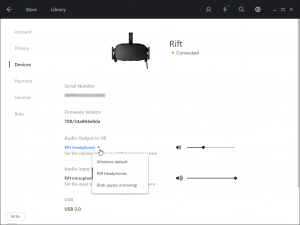Below you will find pages that utilize the taxonomy term “Developing for VR”
Install and run SteamVR on ArchLinux (for using an HTC-Vive) and do OpenGL/OpenVR developement
So, I recently had the chance to try out an HTC-Vive on a Linux machine. Naturally, I installed Arch on it 😉
The installation is pretty straight forward, but there are some little catches if you want to do OpenGL development on Linux With OpenVR (OpenVR is the API you use to talk to the SteamVR runtime.)
SteamVR has a Linux beta since February 2017. They also announced that the SteamVR runtime itself is implemented with Vulkan only.
Getting the name of an audio device from it’s GUID : Using the Oculus Rift selected audio device with OpenAL
So, while working on my game engine, I was curious about looking at the technical requirement for submitting an application to the Oculus Store.
One of the things required is that you need to target the audio output (and input) devices selected by the user in the Oculus app
So, how does the Oculus SDK tells you what is the selected device?
The locomotion problem in Virtual Reality
(Seriously, I hesitated some time between this version and the original, but that’s not the point of this article, and I kinda like the 80’s vibe anyway…)
I think we can all agree here, Virtual Reality (VR) is now, and not science-fiction anymore. “Accessible” (not cheap by any stretch of the imagination) hardware is available for costumers to buy and enjoy. Now you can experience being immersed in virtual worlds generated in real time by a gaming computer and feel presence in it.
The subject that I’m about to address doesn’t really apply to mobile (smartphone powered) VR since theses experiences tend to be static ones. Mobile VR will need to have reliable positional tracking of the user’s head before hitting this issue… We will limit the discussion on actual computer-based VR
One problem still bother me, and the whole VR community as well is: In order to explore a virtual world, you have to, well, walk inside the virtual world. And doing this comfortably for the user is, interestingly, more complex that you can think.
You will allways have a limited space for your VR play room. You can’t physically walk from one town to another in Skyrim inside your living room, the open world of that game is a bit bigger than a few square meters.
The case of cockpit games like Elite:Dangerous aside, simulating locomotion is tricky. Any situation where you’re moving can induce nausea.
Cockpit-based game grounds you in the fact that you’re seated somewhere and “not moving” because most of the object around you don’t move (the inside of the spaceship/car/plane). This make it mostly a no problem, you can do barrel rolls and looping all day long and keep your meal inside your stomach. And you have less chance to kill yourself than inside an actual fighter jet 😉
Simulator (VR) sickness is induced by a disparity between the visual cues of acceleration you get from your visual system, and what your vestibular system sense. The vestibular system is your equilibrium center, it’s a bit like a natural accelerometer located inside your inner ears.
